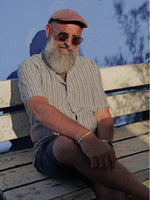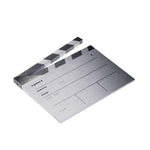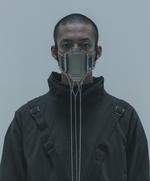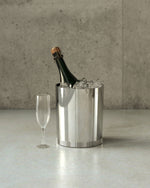19.06.23 in ambassadeurs
Adam Brown
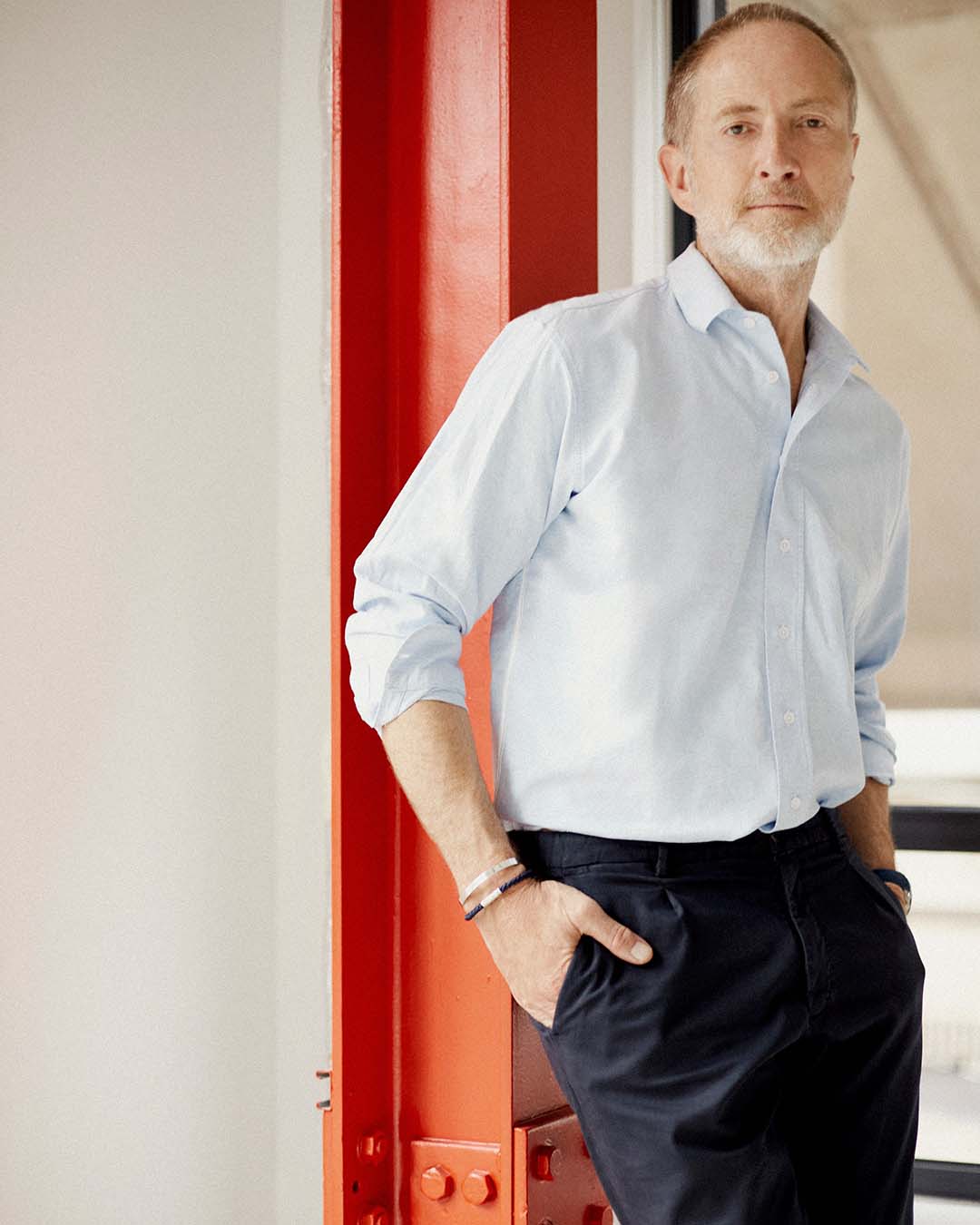

Can you tell us how Orlebar Brown was born?
Orlebar Brown was born in 2007. The idea came to me in 2005, when I was on vacation in India and was refused entry to my hotel restaurant for lunch. It started from a play on words: I told myself that I didn't want swimming shorts, but shorts that I could swim in. There wasn't really a trigger, other than that one time I couldn't get into the restaurant. The original idea therefore comes from the play on words. I did some market research, which mostly consisted of shopping. Nothing scientific. I then took a three-day training course on the fashion industry and then I got started. I made 1,000 shorts that I stored in a storage unit, and I started selling them from my spare bedroom. It was a model available in five colors and four lengths.
What are your sources of inspiration? How would you describe your creative process?
Many people say they find inspiration everywhere, and this is also the case for me. It's a really amazing process, it can happen when I'm reading a magazine on the weekend, when I'm walking in the countryside or when I'm on vacation and I see someone walking into a restaurant, when I'm on a specific beach, or, I don't know, when I'm talking to someone. Inspiration really comes from anywhere. But for Orlebar Brown, it's always something personal. My references are mainly personal experiences. In general, they are linked to a place I went, to a person I met, to an object, to a book I read, to photos I saw. But it very often revolves around travel, as it is the DNA of our brand. It's often a location outside of London, near the ocean. Inspiration can come when I read a book or a film set in that place, or when I walk around a city.
Orlebar Brown now employs more than 140 people. I am at the origin of the creative process. I pitch an idea, a concept for the start of the season, which normally revolves around a word, an object or an article, and then we develop the idea. The design team intervenes, and it then takes 18 months to create the collection, during which we carry out several evaluations of the range as a group. Everything must be encrypted and marked, following the usual steps. But we do it collaboratively. I launch the process, but the achievement is collective. Everyone participates until the launch of the collection. Everyone makes their contribution, but it's not me who designs the products: we have a team of designers in charge of creating the collection. I oversee the whole thing more than I create.
This summer we are celebrating our 15th anniversary, so we will have to celebrate this date in one way or another. The goal is not simply to say “We’re 15, happy birthday!” ". It will be an opportunity to rejoice, to be positive. There must be color. Let's not forget that at 15, we are still a teenager. What did I do when I was 15? Where was I? I remember at one point I was traveling by ferry to visit some Greek islands before heading to Spain. For me, it's the time of Wham! and “Club Tropicana”. Wham! represents my adolescence, my 15 years, but also a way of celebrating joy, the happiness of finding oneself, dynamism, vitality, noise, everything that makes us feel happy. It's a bit cliché, but the idea for our 15th anniversary was to go back to our roots, where we started, and take a moment to refocus, to reflect on our identity, on what we are.
Orlebar Brown was born in 2007. The idea came to me in 2005, when I was on vacation in India and was refused entry to my hotel restaurant for lunch. It started from a play on words: I told myself that I didn't want swimming shorts, but shorts that I could swim in. There wasn't really a trigger, other than that one time I couldn't get into the restaurant. The original idea therefore comes from the play on words. I did some market research, which mostly consisted of shopping. Nothing scientific. I then took a three-day training course on the fashion industry and then I got started. I made 1,000 shorts that I stored in a storage unit, and I started selling them from my spare bedroom. It was a model available in five colors and four lengths.
What are your sources of inspiration? How would you describe your creative process?
Many people say they find inspiration everywhere, and this is also the case for me. It's a really amazing process, it can happen when I'm reading a magazine on the weekend, when I'm walking in the countryside or when I'm on vacation and I see someone walking into a restaurant, when I'm on a specific beach, or, I don't know, when I'm talking to someone. Inspiration really comes from anywhere. But for Orlebar Brown, it's always something personal. My references are mainly personal experiences. In general, they are linked to a place I went, to a person I met, to an object, to a book I read, to photos I saw. But it very often revolves around travel, as it is the DNA of our brand. It's often a location outside of London, near the ocean. Inspiration can come when I read a book or a film set in that place, or when I walk around a city.
Orlebar Brown now employs more than 140 people. I am at the origin of the creative process. I pitch an idea, a concept for the start of the season, which normally revolves around a word, an object or an article, and then we develop the idea. The design team intervenes, and it then takes 18 months to create the collection, during which we carry out several evaluations of the range as a group. Everything must be encrypted and marked, following the usual steps. But we do it collaboratively. I launch the process, but the achievement is collective. Everyone participates until the launch of the collection. Everyone makes their contribution, but it's not me who designs the products: we have a team of designers in charge of creating the collection. I oversee the whole thing more than I create.
This summer we are celebrating our 15th anniversary, so we will have to celebrate this date in one way or another. The goal is not simply to say “We’re 15, happy birthday!” ". It will be an opportunity to rejoice, to be positive. There must be color. Let's not forget that at 15, we are still a teenager. What did I do when I was 15? Where was I? I remember at one point I was traveling by ferry to visit some Greek islands before heading to Spain. For me, it's the time of Wham! and “Club Tropicana”. Wham! represents my adolescence, my 15 years, but also a way of celebrating joy, the happiness of finding oneself, dynamism, vitality, noise, everything that makes us feel happy. It's a bit cliché, but the idea for our 15th anniversary was to go back to our roots, where we started, and take a moment to refocus, to reflect on our identity, on what we are.
“the idea for our 15th anniversary was to return to our roots, where we started, and to take a moment to refocus, to reflect on our identity, on what we are. »


Who are the people who constitute references for you in your profession?
Oh, my God, as my therapist will tell you, everyone except me! Creatively, the starting point for the brand very often comes from family photos, whether it's the basis of a fabric or what my family was doing at one point in their life: traveling , the places she visited. I refer to it often. In fact, I am inspired by all persevering people. It's very easy to kill an idea, but it's also not very difficult to start something. Most people can start a project, but maintaining momentum is more difficult. I find all the people who reach 20, 25, 30 years of experience inspiring. Those who stuck with the brand and made things happen. Those whose brand has retained its identity, its essence, its spirit, its personality, what it is supposed to be. I won't name names, but I think of some people who started brands, kept them afloat, and managed to retain what made them special in the very beginning. These people inspire me. My family photos, old photos, archive images… I also like finding postcards.
Do you have a favorite subject, and if so, how do you approach it?
My favorite material is terry cloth, which reminds me of my grandfather. I have photos of him when he lived in Hong Kong. Every weekend they went boating or to the beach, and he always wore a terrycloth polo shirt. For me, this fabric is romantic. It is evocative. It is ideal for the beach. You can dry it, sweat in it, get it wet. It doesn't keep you too hot. It's not a hot material, and it colors very well. It can be dyed in beautiful dark shades and very soft pastels. For me, for Orlebar Brown, it is the most evocative fabric.
Your biggest challenge achieved or to be achieved?
My biggest challenge achieved... The fact that Orlebar Brown is always true to its essence. It's cliché, but trying to measure and preserve the DNA and essence of something is extremely difficult. What makes me most proud is that we are continually improving. I think the product is improving. May our storytelling improve. May the way we communicate and talk about the holidays improve. My biggest fear has always been seeing our spirit become diluted, having to make compromises as the brand develops. Then we wouldn't be able to do things as well. It's not necessarily an accomplishment, but it's what I'm most proud of.
And if you hadn't founded OB, what job would you have liked to do?
I was 40 years old when I founded Orlebar Brown. Before that, I was one of those people who doesn't know what they want to do with their life. I worked in the charity sector for around ten years. I have worked in the AIDS field, in prisons and for children's charities. I was then offered a good job, but I wasn't interested. So I went back to college, studied photography, and worked as a photographer for six years, but I was terrible at it. At 40, I found myself without a real career. I didn't know what I wanted. I didn't have an unpleasant life, but I didn't have a career. I didn't know what I wanted to do. I couldn't find what I liked. I was very lucky to find Orlebar Brown, because I really don't know if I could have been a real estate agent. I could eventually work in marketing.
Oh, my God, as my therapist will tell you, everyone except me! Creatively, the starting point for the brand very often comes from family photos, whether it's the basis of a fabric or what my family was doing at one point in their life: traveling , the places she visited. I refer to it often. In fact, I am inspired by all persevering people. It's very easy to kill an idea, but it's also not very difficult to start something. Most people can start a project, but maintaining momentum is more difficult. I find all the people who reach 20, 25, 30 years of experience inspiring. Those who stuck with the brand and made things happen. Those whose brand has retained its identity, its essence, its spirit, its personality, what it is supposed to be. I won't name names, but I think of some people who started brands, kept them afloat, and managed to retain what made them special in the very beginning. These people inspire me. My family photos, old photos, archive images… I also like finding postcards.
Do you have a favorite subject, and if so, how do you approach it?
My favorite material is terry cloth, which reminds me of my grandfather. I have photos of him when he lived in Hong Kong. Every weekend they went boating or to the beach, and he always wore a terrycloth polo shirt. For me, this fabric is romantic. It is evocative. It is ideal for the beach. You can dry it, sweat in it, get it wet. It doesn't keep you too hot. It's not a hot material, and it colors very well. It can be dyed in beautiful dark shades and very soft pastels. For me, for Orlebar Brown, it is the most evocative fabric.
Your biggest challenge achieved or to be achieved?
My biggest challenge achieved... The fact that Orlebar Brown is always true to its essence. It's cliché, but trying to measure and preserve the DNA and essence of something is extremely difficult. What makes me most proud is that we are continually improving. I think the product is improving. May our storytelling improve. May the way we communicate and talk about the holidays improve. My biggest fear has always been seeing our spirit become diluted, having to make compromises as the brand develops. Then we wouldn't be able to do things as well. It's not necessarily an accomplishment, but it's what I'm most proud of.
And if you hadn't founded OB, what job would you have liked to do?
I was 40 years old when I founded Orlebar Brown. Before that, I was one of those people who doesn't know what they want to do with their life. I worked in the charity sector for around ten years. I have worked in the AIDS field, in prisons and for children's charities. I was then offered a good job, but I wasn't interested. So I went back to college, studied photography, and worked as a photographer for six years, but I was terrible at it. At 40, I found myself without a real career. I didn't know what I wanted. I didn't have an unpleasant life, but I didn't have a career. I didn't know what I wanted to do. I couldn't find what I liked. I was very lucky to find Orlebar Brown, because I really don't know if I could have been a real estate agent. I could eventually work in marketing.
“The starting point for the brand very often comes from family photos, whether it's the basis of a fabric or what my family was doing at a certain point in their life: traveling, places that she was visiting. I refer to it often. »

A favorite place where you can usually be found? A place that suits you?
Right now, it's the southwest of England, more precisely Cornwall, the pointy point at the bottom left on the map. I used to go there as a child. My grandmother took me there for four weeks in the summer and four weeks at Easter. The waves break on large rocks, it is a very windy place, ideal for surfing. Nothing to do with the Mediterranean. It's not quiet, it's not as loud and bright and exposed to the wind. I live there part of the time, and I love this region. I just love going to these big beaches every day and watching the waves crash, with the dogs. It's my little paradise.
Do you have a favorite object? How much does he weigh ?
Yes, a bar of dark chocolate. I eat chocolate every day.
What did you like about the idea of a collaboration with Le Gramme?
We are constantly looking for new things. We started with shorts, then we created t-shirts and polo shirts. I love seeing how Orlebar Brown can become an accessory while still maintaining its style. Men's jewelry is something magnificent. This has always interested me. What I like is that, especially when I go on vacation, I tend to wear bracelets, bangles or similar. There is a form of purity, essence and spirit in everything Le Gramme does, which is reminiscent of Orlebar Brown. Your story is very close to ours. The brand’s DNA and values must match. They can be interpreted in completely different ways, but I think it's important to find two brands that feel like they have their roots in the same place. This is what I like about this collaboration.
What do Le Gramme creations inspire you?
When I think of Orlebar Brown, the words that come to mind are: sunshine, travel, happiness and good times. When I see the Le Gramme bracelets that we created together, I feel that they bring sunshine, joy, and that they make you want to travel and have good times.
If Le Gramme were a piece of clothing, what would it be?
A navy blue terry cloth polo shirt, named Terry.
How to wear your Orlebar Brown x Le Gramme bracelet?
It does not matter. I don't even think about it, I think about the beauty of things: finding the right watch, the right bracelet, the right piece. You shouldn't think about it. Whether it's navy blue or navy blue and red, there are times when you appreciate color. Where your navy goes with everything. For me, it's a pleasure. I am, by nature, a little lazy. I don't want to think about it, I'm just really happy to wear whatever is near my bed. Just put it on, put your watch on, and off you go.
Right now, it's the southwest of England, more precisely Cornwall, the pointy point at the bottom left on the map. I used to go there as a child. My grandmother took me there for four weeks in the summer and four weeks at Easter. The waves break on large rocks, it is a very windy place, ideal for surfing. Nothing to do with the Mediterranean. It's not quiet, it's not as loud and bright and exposed to the wind. I live there part of the time, and I love this region. I just love going to these big beaches every day and watching the waves crash, with the dogs. It's my little paradise.
Do you have a favorite object? How much does he weigh ?
Yes, a bar of dark chocolate. I eat chocolate every day.
What did you like about the idea of a collaboration with Le Gramme?
We are constantly looking for new things. We started with shorts, then we created t-shirts and polo shirts. I love seeing how Orlebar Brown can become an accessory while still maintaining its style. Men's jewelry is something magnificent. This has always interested me. What I like is that, especially when I go on vacation, I tend to wear bracelets, bangles or similar. There is a form of purity, essence and spirit in everything Le Gramme does, which is reminiscent of Orlebar Brown. Your story is very close to ours. The brand’s DNA and values must match. They can be interpreted in completely different ways, but I think it's important to find two brands that feel like they have their roots in the same place. This is what I like about this collaboration.
What do Le Gramme creations inspire you?
When I think of Orlebar Brown, the words that come to mind are: sunshine, travel, happiness and good times. When I see the Le Gramme bracelets that we created together, I feel that they bring sunshine, joy, and that they make you want to travel and have good times.
If Le Gramme were a piece of clothing, what would it be?
A navy blue terry cloth polo shirt, named Terry.
How to wear your Orlebar Brown x Le Gramme bracelet?
It does not matter. I don't even think about it, I think about the beauty of things: finding the right watch, the right bracelet, the right piece. You shouldn't think about it. Whether it's navy blue or navy blue and red, there are times when you appreciate color. Where your navy goes with everything. For me, it's a pleasure. I am, by nature, a little lazy. I don't want to think about it, I'm just really happy to wear whatever is near my bed. Just put it on, put your watch on, and off you go.
“When I see the Le Gramme bracelets that we created together, I feel that they bring sunshine, joy, and that they make you want to travel and have good times. »
---accumulation---
bracelet_7g_silver-925_brush_smooth_cable-nato-marine-red_orlebar-brown;bracelet_7g_silver-925_brush_smooth_cable-nato-marine_orlebar-brown;bracelet_21g_silver-925_polished_smooth_ruban
